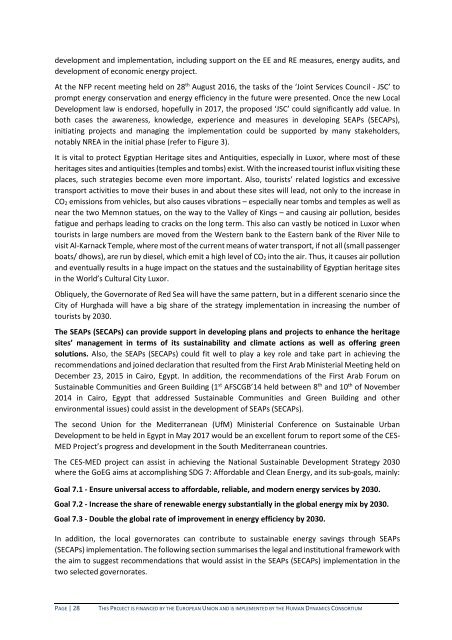180917_CES-MED_National_Report_Egypt_FINAL2rev
Create successful ePaper yourself
Turn your PDF publications into a flip-book with our unique Google optimized e-Paper software.
development and implementation, including support on the EE and RE measures, energy audits, and<br />
development of economic energy project.<br />
At the NFP recent meeting held on 28 th August 2016, the tasks of the ‘Joint Services Council - JSC’ to<br />
prompt energy conservation and energy efficiency in the future were presented. Once the new Local<br />
Development law is endorsed, hopefully in 2017, the proposed ‘JSC’ could significantly add value. In<br />
both cases the awareness, knowledge, experience and measures in developing SEAPs (SECAPs),<br />
initiating projects and managing the implementation could be supported by many stakeholders,<br />
notably NREA in the initial phase (refer to Figure 3).<br />
It is vital to protect <strong>Egypt</strong>ian Heritage sites and Antiquities, especially in Luxor, where most of these<br />
heritages sites and antiquities (temples and tombs) exist. With the increased tourist influx visiting these<br />
places, such strategies become even more important. Also, tourists’ related logistics and excessive<br />
transport activities to move their buses in and about these sites will lead, not only to the increase in<br />
CO 2 emissions from vehicles, but also causes vibrations – especially near tombs and temples as well as<br />
near the two Memnon statues, on the way to the Valley of Kings – and causing air pollution, besides<br />
fatigue and perhaps leading to cracks on the long term. This also can vastly be noticed in Luxor when<br />
tourists in large numbers are moved from the Western bank to the Eastern bank of the River Nile to<br />
visit Al-Karnack Temple, where most of the current means of water transport, if not all (small passenger<br />
boats/ dhows), are run by diesel, which emit a high level of CO 2 into the air. Thus, it causes air pollution<br />
and eventually results in a huge impact on the statues and the sustainability of <strong>Egypt</strong>ian heritage sites<br />
in the World’s Cultural City Luxor.<br />
Obliquely, the Governorate of Red Sea will have the same pattern, but in a different scenario since the<br />
City of Hurghada will have a big share of the strategy implementation in increasing the number of<br />
tourists by 2030.<br />
The SEAPs (SECAPs) can provide support in developing plans and projects to enhance the heritage<br />
sites’ management in terms of its sustainability and climate actions as well as offering green<br />
solutions. Also, the SEAPs (SECAPs) could fit well to play a key role and take part in achieving the<br />
recommendations and joined declaration that resulted from the First Arab Ministerial Meeting held on<br />
December 23, 2015 in Cairo, <strong>Egypt</strong>. In addition, the recommendations of the First Arab Forum on<br />
Sustainable Communities and Green Building (1 st AFSCGB’14 held between 8 th and 10 th of November<br />
2014 in Cairo, <strong>Egypt</strong> that addressed Sustainable Communities and Green Building and other<br />
environmental issues) could assist in the development of SEAPs (SECAPs).<br />
The second Union for the Mediterranean (UfM) Ministerial Conference on Sustainable Urban<br />
Development to be held in <strong>Egypt</strong> in May 2017 would be an excellent forum to report some of the <strong>CES</strong>-<br />
<strong>MED</strong> Project’s progress and development in the South Mediterranean countries.<br />
The <strong>CES</strong>-<strong>MED</strong> project can assist in achieving the <strong>National</strong> Sustainable Development Strategy 2030<br />
where the GoEG aims at accomplishing SDG 7: Affordable and Clean Energy, and its sub-goals, mainly:<br />
Goal 7.1 - Ensure universal access to affordable, reliable, and modern energy services by 2030.<br />
Goal 7.2 - Increase the share of renewable energy substantially in the global energy mix by 2030.<br />
Goal 7.3 - Double the global rate of improvement in energy efficiency by 2030.<br />
In addition, the local governorates can contribute to sustainable energy savings through SEAPs<br />
(SECAPs) implementation. The following section summarises the legal and institutional framework with<br />
the aim to suggest recommendations that would assist in the SEAPs (SECAPs) implementation in the<br />
two selected governorates.<br />
PAGE | 28<br />
THIS PROJECT IS FINANCED BY THE EUROPEAN UNION AND IS IMPLEMENTED BY THE HUMAN DYNAMICS CONSORTIUM

















